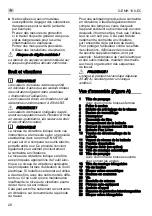
GE MH 18.0-EC
22
3. Insert mains plug.
4. Set required speed.
5. Switch on dust extraction system.
6. Hold the wall sander with both hands.
This provides the best possible
combination of range and leverage
for the application.
7. Switch on the device.
8. Press the wall sander gently against
the work surface (the pressure should
be just enough to ensure that the san-
ding head is flush with the work sur-
face).
9. Increase the pressure to bring the san-
ding sheet into contact with the work
surface. In doing so, swing the sander
in overlapping movements to smooth
the surface to the required fineness.
CAUTION!
The rotating parts of the sanding head must
not come into contact with sharp projecting
objects (e.g. nails, screws, junction boxes).
The Velcro pad may be damaged if it comes
into contact with projecting objects.
The Velcro pad can be replaced if it
is damaged or severely abraded (see
section entitled “Maintenance and care”).
Operating instructions
Brush ring
A brush-type ring surrounds the sanding
head. This ring has two functions:
– As the ring projects above the surface
of the sanding plate, it is the ring which
comes into contact with the work surface
first. As a result, the sanding head
is brought parallel to the work surface
before the sanding tool comes into
contact with the work surface.
This avoids a sickle-shaped depression
caused by the edge of the sanding disc.
– The ring also retains the dust until
it is extracted by the dust extractor.
If the brush ring is damaged or shows
excessive wear, it should be replaced
(see section entitled “Maintenance and
care”). Replacement brush rings are availa-
ble from any FLEX customer service centre.
Sanding in dry construction
The wall sander features a unique swivel
head. As this head can swivel in different
directions, the sanding head can
be adjusted to the work surface.
As a result, the user can sand the upper,
middle and lower wall areas or ceiling pro-
files without having to change his position.
When working, apply only as much pressure
as is required to keep the sanding plate
in contact with the work surface. Excessive
pressure may result in a disagreeable spiral
pattern of scratches and an uneven work
surface.
Move the sander constantly while the san-
ding plate is in contact with the work sur-
face. In doing so, ensure that you move
the sander evenly and over a wide area.
If you stop the sander on the work surface
or move the sander unevenly, this may
result in a disagreeable spiral pattern
of scratches and an uneven work surface.
NOTE
In the event of overload or overheating in
non-stop operation, the power tool will
switch off.
To continue working, switch the power tool
off and back on again.
Triangular sanding head (Figure N)
The triangular sanding head does not
rotate, but vibrates.
As the triangular sanding head can revolve
on bearings, it can sand right into the
corners of the wall/ceiling.
Maintenance and care
WARNING!
Remove the battery before carrying out any
work on the power tool.
Cleaning (Figure O)
WARNING!
Do not use water or liquid detergents.
Clean the power tool and grille in front of
the vent slots regularly. Frequency of
cleaning is dependent on the material
and duration of use.
Содержание GE MH 18.0-EC
Страница 1: ...GE MH 18 0 EC ...
Страница 3: ...3 GE MH 18 0 EC ...
Страница 4: ...4 GE MH 18 0 EC ...
Страница 5: ...5 GE MH 18 0 EC ...
Страница 6: ...6 GE MH 18 0 EC ...
Страница 222: ...222 GE MH 18 0 EC FLEX N O V ...
Страница 223: ...223 GE MH 18 0 EC FLEX H 1 2 M 1 2 3 4 5 6 7 8 9 ...
Страница 225: ...225 GE MH 18 0 EC EN60745 EN 60745 85 ...
Страница 226: ...226 GE MH 18 0 EC ...
Страница 227: ...227 GE MH 18 0 EC 221 GE MH 18 0 EC FLEX 1900 GE MH 18 0 EC M ...
Страница 228: ...504 661 03 2021 Für Druckfehler keine Gewähr Technische Änderungen vorbehalten ...
















































